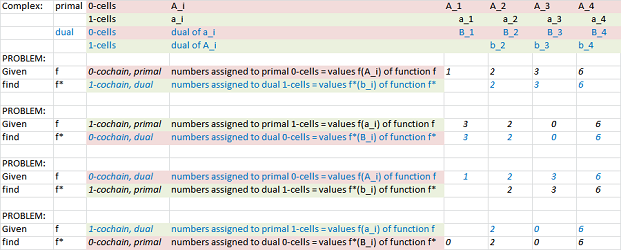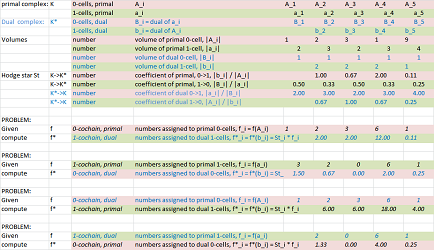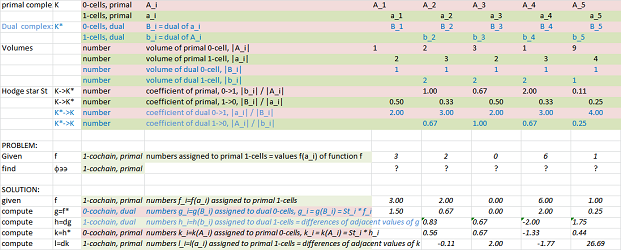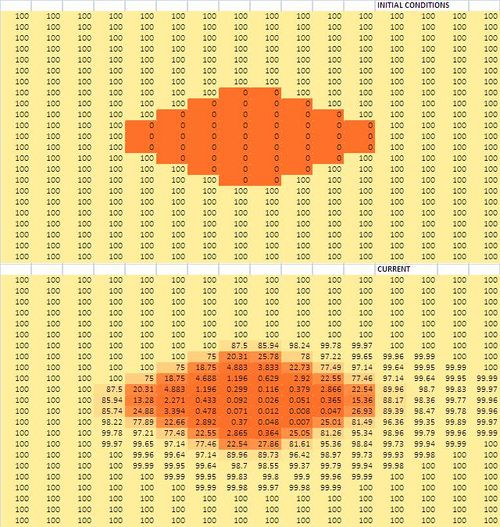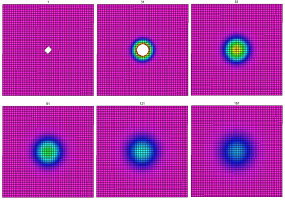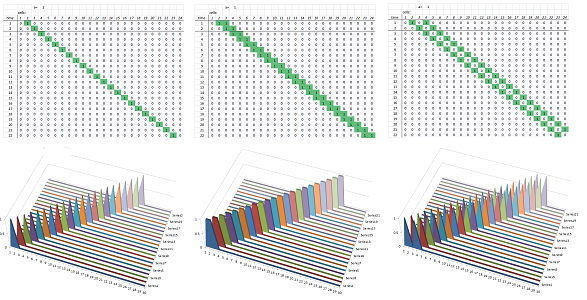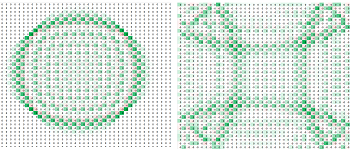This site is being phased out.
Spreadsheets
Contents
Topology
Boundary operator: boundary_operator_binary.xlsx
Link to the file: boundary_dim_2.xlsx
Vector fields
Settings
For motion simulation, do one step at a time:
Flow simulation
Dimension 1
The settings for formulas are:
- Manual,
- 1 Iteration.
- Push: Calculate now
Link to the file: vector field_dim_1.xlsx
Dimension 2
Same settings.
Link to the file: vector field_dim_2.xlsx Link to the file: vector field_dim_2.xlsx
Advection
Differential forms
Settings
For some simulations iterations are required:
Dimension 1
Link to the file: boundary_dim_1.xlsx
Link to the file: Exterior_derivative_dim_1.xlsx
Link to the file: Hodge_duality_dim_1.xlsx
Hodge duality with geometry:
Link to the file: Hodge_duality_dim_1_w_geometry.xlsx
Link to the file: Laplacian_dim_1.xlsx
Laplacian with geometry:
Link to the file: Laplacian_dim_1_w_geometry.xlsx
Dimension 2
Warning: you will need to use a buffer sheet because Excel's row-by-row manner of evaluation will cause a skewed pattern:
Diffusion
The recursive formula for the simulation: $$U(a, t+1):= U(a,t) + \Big[- k(a) \left( U(a) - U(a-1)\right) + k(a+1) \left( U(a+1) - U(a)\right)\Big].$$ The Excel setup is shown below:
The result after $1,500$ iterations is shown next:
Files:
Dimension $2$.
A simulation of heat transfer from single point is shown below:
File:
What if the horizontal walls are longer than the vertical ones? Then more heat should be exchanged across the vertical walls than the horizontal ones: $$RC= RC - k*\bigg( .5*\left(RC-RC[-1]\right) + .5*\left(RC-RC[1]\right) + 2*\left(RC-R[-1]C\right) + 2*\left(RC-R[1]C\right) \bigg).$$ As a result, the material does travel farther -- as measured by the number of cells -- in the vertical direction (second image) than normal (first image):
Wave propagation
Dimension $1$:
The Excel formula is:
- =R1C5*R[-1]C[-1]+2*(1-R1C5)*R[-1]C+R1C5*R[-1]C[1]-R[-2]C
Here cell R1C5 contains the value of $\alpha$.
The simplest propagation pattern is given by $\alpha=1$. Below we show the propagation of a single bump, a two-cell bump, and two bumps:
Dimension $2$:
Social choice
To experiment with PageRank, use Link to the file: Spreadsheets.this spreadsheet: pagerank.xlsx.
To experiment with decycling comparison elections, use this spreadsheet: decycled_elections.xlsx.






